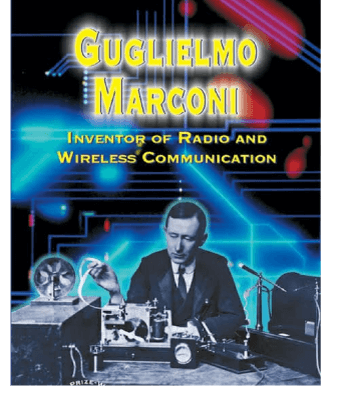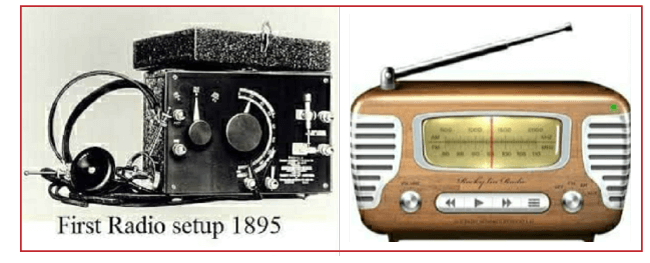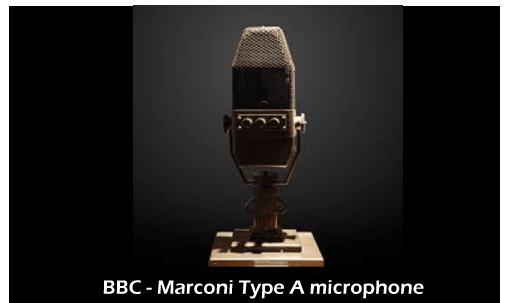Who invented radio?It was the 1860s when Scottish physicist James Maxwell predicted the presence of radio waves in space. After that, Heinrich Hertz explained that the swift variations of electric currents could be transmitted to space as radio waves. Guglielmo Marconi, an Italian engineer, transmitted the first radio signals. He was considered the first inventor of the radio. He transmitted as well as got the first radio signal in 1895. That radio transmissions were coded signals that were transmitted to a distance of just over a kilometer. 
Development of Marconi's radioThe developments of Marconi's radio are as follows: 1. Who inspired Marconi for his invention?Guglielmo Marconi (1874-1937) was born in Italy. His father was a rich landlord, and his mother belonged to a famous winemaker family of Ireland. He had done his studies form the Livorno technical institution as well as the University of Bologna. In 1894 Marconi was very much interested in Heinrich Rudolf Hertz's finding of invisible waves. Those invisible waves were produced by electromagnetic interaction. Later with his inspiration, he developed a device that could have produced the invisible waves. For testing, he sent a signal away from his location, and it was a successful attempt. 2. Marconi's successful experiments

3. Some other inventors who claimed for their patent firstThere are some more scientists who had a claim as the first inventor of the radio. They were; the Russian physicist Alexander Popov who was broadcasting between buildings in 1895. An Indian scientist Jagdish Chandra Bose also did an experiment with radio waves and used that for ringing bells as well as for triggering explosions. In 1901 Nikola Tesla, an American who was also one of the inventors of electricity, revealed that he had experimented with the wireless telegraph in 1893. As a result of these claims, U.S Supreme Court invalidated four of Marconi's radio patents in 1943 as citing Tesla's prior work.
Nikola Tesla, a Serbian-American scientist, was originally a Serbian, but later, in 1884, he migrated to the United States. There he developed the induction coil that is also known as the Tesla coil. Through this equipment, he was able to transmit the radio waves. But, all the documents and equipment of Tesla were burnt due to a fire in his lab in 1895. That time he had developed a device with which he could have sent the signal 50 miles away. Whereas in 1896, Marconi invented and sent & received Morse code-based radio signals at distances nearly four miles (6 km) in England, and also he applied for a patent. There he successfully got the patent for the first wireless telegraphy in the world.
However, Tesla applied for his first patents in radio in 1897 in America, and in 1900 he granted Tesla patents 645,576 and 649,621. Marconi also applied for a patent for tuned telegraphy in November 1897, but at first patent office denied Marconi's applications. Marconi reapplied for three years, and finally, in 1904, the U.S patent office reversed its earlier decision and gave the Italian the patent no. 7777 for the invention of the radio. Later again, Tesla sued Marconi's company for infringement in 1915. In 1943, during World War I, the company of Marconi summoned the government of the United States for the violation of his patent. But the U.S Supreme Court upheld patent 645,576 for restoring Tesla as the inventor of the radio. However, still, people considered Marconi as the father of the radio. 4. Large numbers of Marconi patents and "Type A" microphoneMarconi published his last transmitter patent in 1920. Overall his total work on the radio transmitter was almost 100 published patent documents during the span of 23 years. The fourth-generation "Type A" microphones of Marconi were used widely by BBC from the 1930s onwards. It also symbolizes the BBC. 
5. Marconi's last tours and his deathLater, Marconi continued improvements in his inventions as well as his experiment with shortwave broadcasts. He returned to Italy. Here he became a supporter of Benito Mussolini. Thereafter he went on the tour of Brazil as well as Europe in 1935. There he supported Mussolini in conquering Abyssinia. After two years, he died of a heart attack in Rome, and for paying him tribute and honor, the radio stations in America, England, and Italy were silenced for several minutes. 6. Importance and acceptance of Marconi's deviceThe U.S. army communicated on wireless with faraway ships in 1899. After this successful wireless communication in 1901, the navy took up this technology. Before wireless technology, they had been used another way to communicate with faraway ships or people like they had been used pigeon as a messenger for sending and receiving the messages and also used some other way for establishing communication. In the same year, the service of radiotelegraph had been established in the Hawaiian Islands. President Theodore Roosevelt communicated through the Marconi's radio station of Massachusetts in 1903. He talked with King Edward VII. At the time of war, like Russo Japanese war, this wireless system is used for reporting in some battles of the navy. In 1906 to speed up the notice of weather conditions, the U.S weather bureau used the radiotelegraph. 7. Marconi's device saved people's life.Moreover, in 1912 when the Titanic clashed with an iceberg and after it starts sinking, at that moment, it was Marconi's operator who was able to establish communication for picking up the 700 survivors from the spot. So navy and other shipping companies accepted the benefits of this technology, as they can establish communication in any circumstances with any place. After this recognition, Marconi's wireless company became the standard device for communication.
The radiotelegraph was used by the governments during World War I to instruct the movements of troops and supplies as well as to be alert of events. Later the value of radio is demonstrated by World WarII, and it is developed and utilized for peacetime purposes. The development of the radiotelegraph made communication possible with any place for the people of the United States. 8. Development of radiophotograph and microwave beamIn 1923 a new experiment took place. In this experiment, a photograph was transmitted from Washington to Baltimore by wire. After this, the first transatlantic radiophoto relay was occurred in America, in which the picture of Charles Evans Hughes was beamed from London to New York. In 1926 RCA inaugurated regular radiophoto service. Further, the first microwave beam system was established by the western union in 1945. By this system, they connected New York with Philadelphia. Thereafter it was developed and tested by 1988, about 2000 telegrams in one time transmitted by the western union.
It was considered that the first human voice transmitted by the radio was 'Hello Rainey' in 1892. The word is spoken by Natan B. Stubblefield to his test partner near Murray, Kentucky. After this, in 1915, the first continental speech was communicated as well as in the same year the several communications were established across the Atlantic Ocean. And then rapidly this radio and wireless technology became the widely accepted technology as various Atlantics and transatlantic communications had been taken place by this system.
Moreover, in 1927 commercial radiotelephony was opened first between North America with Europe and later South America also included. The first call on telephone was established in 1935. This call became possible due to combining the wire with radio circuits. However, the American transatlantic telephone communication had to rout through England, but by 1936, a direct radiotelephonic circuit was opened to Paris. Now the telephone connection by radio and cable is accessible with 187 foreign points.
Next TopicWho invented telephone
|
 For Videos Join Our Youtube Channel: Join Now
For Videos Join Our Youtube Channel: Join Now
Feedback
- Send your Feedback to [email protected]
Help Others, Please Share










